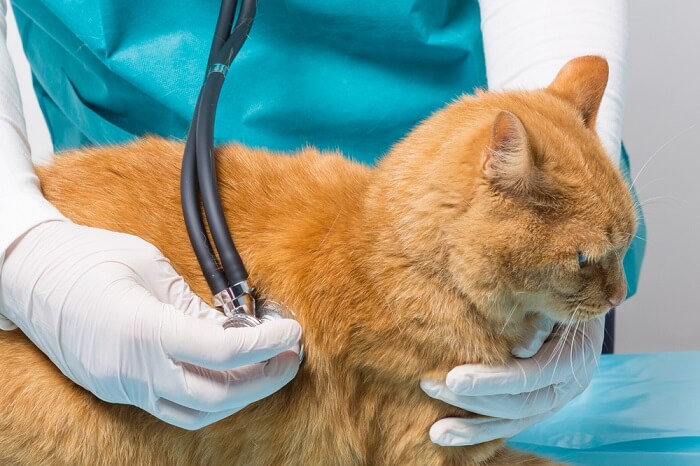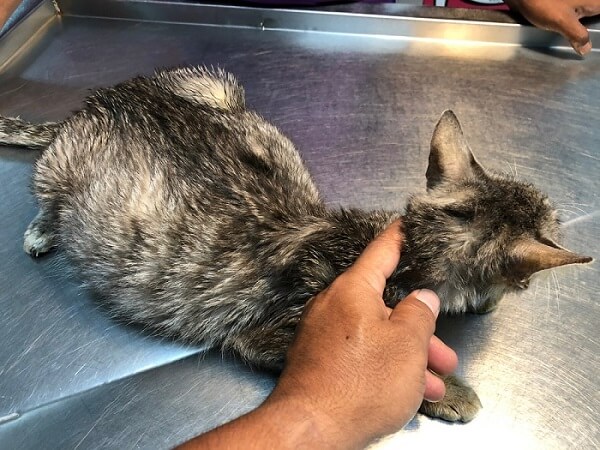
Like in humans, lung cancer in cats can be extremely serious, and as a pet owner, it can be a very scary time. Knowing what symptoms to look for and what happens after diagnosis will mean you’re completely prepared if your cat is diagnosed with a lung tumour.
Quick Overview: Lung Cancer In Cats
 Common Symptoms: Difficulty breathing (dyspnea), rapid breathing (tachypnea), lethargy, poor appetite, weight loss, coughing, coughing up blood
Common Symptoms: Difficulty breathing (dyspnea), rapid breathing (tachypnea), lethargy, poor appetite, weight loss, coughing, coughing up blood
 Diagnosis: X-ray, CT scan, MRI. Ultrasound may also be used to evaluate tumors and/or fluid build-up in the chest.
Diagnosis: X-ray, CT scan, MRI. Ultrasound may also be used to evaluate tumors and/or fluid build-up in the chest.
 Requires Ongoing Medication: Sometimes, if chemotherapy is a part of treatment.
Requires Ongoing Medication: Sometimes, if chemotherapy is a part of treatment.
 Vaccine Available: No
Vaccine Available: No
 Treatment Options: Surgical removal, especially of single tumors. Additional radiotherapy and chemotherapy in applicable cases. If a tumor has caused fluid build-up in the chest, thoracocentesis may be performed where a needle and syringe are used to remove the fluid to help a kitty breathe better.
Treatment Options: Surgical removal, especially of single tumors. Additional radiotherapy and chemotherapy in applicable cases. If a tumor has caused fluid build-up in the chest, thoracocentesis may be performed where a needle and syringe are used to remove the fluid to help a kitty breathe better.
 Home Remedies: None
Home Remedies: None
What Is Lung Cancer in Cats?
‘Cancer’ means an abnormal proliferation of cells- they grow and increase in size and number and are immune to the body’s usual ‘stop’ signals. ‘Tumors’ form as these cells grow into a large lump.
Lung cancer (properly called pulmonary neoplasia) is any sort of tumour that grows in the lungs. This can cause a big problem, as the tumour takes up space that the lungs need in order to work effectively.
Types of Lung Cancer in Cats
Primary Lung Cancer
Tumors that grow in the lungs first, rather than metastasize there from elsewhere in the body, are called ‘primary’ lung tumours.
They are fairly rare in cats, accounting for less than 1% of cancer cases in cats- although these types of tumour are on the increase.
Primary lung tumours usually affect older cats (average age 12 years), and may be more common in Persian cats.
The most common primary lung tumour in cats is pulmonary adenocarcinoma, which can arise from the bronchus (the tubes that carry air into the lungs) or from the alveolae (the air sacs). Squamous cell carcinoma and bronchioalveolar carcinoma are other types of cancer that occur in cat lungs.
Primary lung tumours are often malignant, with around three quarters metastasizing to other parts of the body such as the lymph nodes, bone, or liver. Feline lung-digit syndrome is common- this is where the lung tumour spreads to the toes, causing swelling and lameness.
Although this swelling is sometimes the first symptom of lung cancer in cats, the cancer is often very far advanced by this stage and the prognosis is unfortunately very poor for cats with lung-digit syndrome.
Secondary Lung Cancer
Many cancers spread to the lungs from elsewhere in the body, and we call this a ‘secondary’ lung tumour or ‘metastatic lung tumour’. Almost any malignant tumour type can metastasize to the lungs, although lymphoma, mammary cancer and bone cancer (osteosarcoma) are some of types of cancer that are most likely to spread to the lungs.
Because so many tumours metastasize to the lungs, secondary lung cancer is much more common than primary lung cancer.
Causes of Lung Cancer in Cats

The exact causes of lung cancer in cats are poorly-understood. It’s suggested that retroviruses and exposure to environmental tobacco smoke may be risk factors, but we don’t know anything definitive.
The causes of lung cancer in cats are poorly understood. We know that the number of cases is increasing, but it isn’t clear if this is due to longer life expectancy, better awareness, increased funds for investigation, better imaging techniques, genetics, or exposure to a higher number of carcinogens. It’s likely it’s a combination of factors.
One suggestion is that retroviruses such as FeLV and FIV may have some impact on a cat’s lung cancer risk. Some lung cancers in other species are spread by retroviruses, and we know that FeLV increases the risk of lymphoma. However, there’s no evidence that this is the case for primary lung tumours in cats at present.
Read More: Feline Leukemia Virus: Causes, Symptoms, & Treatment
As in people, it’s possible that exposure to cigarette smoke (environmental tobacco smoke) could be a risk factor for lung tumours in cats. Although there is currently no direct evidence for this, we know that passive smoke inhalation increases the risk of some oral tumours in cats, and that passive smoking increases the risk of lung tumours in humans and dogs.
In fact, in some ways, cats are in more danger from second-hand smoke- they can ingest the toxins when grooming.
Symptoms of Feline Lung Cancer
Lung tumours in cats are often asymptomatic- cats are masters at hiding signs of trouble and may show no symptoms of lung cancer for a long time. In fact, it’s estimated that around a third of lung tumours are found when x-raying for another reason.
When cats do show signs, difficulty breathing (dyspnea) is common- as is fast breathing (tachypnea). Panting, abdominal effort when breathing, wheezing, coughing, and inability to exercise are also signs of lung tumours in cats.
Thanks to lung-digit syndrome, lameness caused by swelling of several toes, or discharge from the nail beds, can also be clinical signs of lung cancer in cats.
Other symptoms of lung cancer include:
- Cough
- Exercise intolerance
- Panting
- Lethargy
- Vomiting
- Inappetence (anorexia)
- Weight loss
- Lameness
- Discharge from nail beds
- Wheezing
- Fever
- Drinking more than usual
- Urinating more than usual
- Hair loss
If your veterinarian suspects lung cancer, the first thing they will do is conduct a full physical exam, including listening to the chest. Bloodwork (biochemistry and hematology) often follow, to assess any changes to organs that may indicate whether the cancer has spread.
This also helps to assess the safety of anesthesia. Imaging- with chest x-rays, or with CT scans- is next. This helps your veterinarian to determine the size of the tumour and may reveal metastases.
Once the tumour has been located, the next step is to locate evidence of metastases. With three quarters of lung tumours spreading, your vet will want to find out where the tumour has spread to in order to give a prognosis and treatment plan.
The tumour may need to be sampled, and lymph nodes in the area should be checked, as these are common sites of metastasis. These samples are usually collected by fine needle aspiration (FNA) also known as ‘needle biopsy’, and the cancer cells sent to a pathologist at a specialist lab for cytology (analysis).
If the FNA doesn’t give enough information, a larger biopsy of lung tissue can be taken under an anesthetic for histopathology.
Lung Cancer in Cats Treatment

Unfortunately, the prognosis for lung cancer is often poor, meaning that treatment may be palliative rather than focused on curing the disease.
Unfortunately, lung cancer in cats carries a poor prognosis, and treatment is often ‘palliative’- to reduce symptoms, rather than cure the disease. Your veterinarian will discuss the treatment options with a veterinary oncologist to determine the best course of action for your cat.
Surgical removal of the primary lung tumour or lung lobe is possible, especially if no metastases have been detected. This involves a ‘thoracotomy’- major open-chest surgery that is usually only offered at specialist centers due to the high risks involved. If metastases are present, surgery like this is unlikely to bring enough benefit to make the high-risk procedure worthwhile.
Chemotherapy and radiotherapy (radiation therapy) is sometimes recommended, especially where metastatic spread has already happened.
If the tumour has caused a pleural effusion, this can be drained to provide some relief.
Conclusion
Lung tumours in cats are rare but cases are on the increase, so it’s worth being aware of the signs. As with all tumours, the sooner they’re identified the better, but it’s worth being prepared for bad news- lung tumours often have a poor prognosis, especially once the disease has spread.
Frequently Asked Questions
How long can cats live with lung cancer?
Unfortunately, average lung cancer survival time is less than six months, although it can be over a year if the tumour is detected before it metastasizes. The prognosis is worse with lung-digit syndrome, with survival time averaging just a couple of months. Cats are usually euthanized due to their metastatic disease.
Is lung cancer painful for cats?
Vets are not sure if lung cancer is painful for cats, as they hide it so well. We know that 1 in 5 humans with lung cancer report pain, and it seems likely that lung cancer can be painful for cats, too. Metastases can be painful, especially to the bones or in lung-digit syndrome.
What are the symptoms of lung cancer in cats?
The signs of lung cancer in cats are often subtle or non-existent. When signs do exist, panting, lethargy, weight loss, and toe swelling are common.
Can lung cancer in cats be treated?
If caught early, it’s theoretically possible for lung cancer to be treated. However, most cases go undetected until a late stage, and ‘treatment’ is usually palliative with the aim of reducing symptoms and improving quality of life. Feline lung cancer is eventually fatal in most cases.








I have once bên diagnosed with tuberculosis and to be honest, that was one of the worst moments in my life when I couldn’t breathe properly, my lung felt hurt and I had to take tons of medicines and antibiotics. I just cant imagine that some lovely cats might have lung cancer, and I don’t know if every owner on Earth is willing to seek remedy for their pets or just let them there till the last breath…
Our cat,Cindy,was just diagnosed with lung cancer yesterday. We adopted her about 12 yrs ago.She is believed to be almost 15yrs old.She is a dark Tortie.Nothing seemed out of the ordinary until 2 nights ago.She was lethargic,refusing food.Yesterday morning more lethargy,no food.Took her to vet.We know that she was at beginning stage of kidney disease 4 months ago.She had a diarrhea problem back then.Then she was fine,playful,eatting,drinking.They did xrays yesterday,she had enlarged heart,and lung cancer.Because of her age,they did not recommend surgery.They did not talk about pain killers or Bronchodilator until hours later,they called us right before closing time.Now we are having a major snow storm that will last for days.She started crying at 2am last night. The veterinary hospital is closed due to the storm,and this cat is crying.We can’t believe how quickly she presented with these symptoms.If anyone tells you that lung cancer does not hurt cats, they are wrong!!
So sad. I hope your cat gets relief. Our Gabby just had a chest X-Ray today .It showed a small mass. Enlarged heart. She will be 16 soon. She has asthma.
My cat was put on steroids anti biotics and deucretics and put in saturated oxygen kennel and died .before dying had fluid taken from chest with syringe , could any of these caused his death ???
Carol, it’s nearly impossible to say from this description if any mistakes during treatment contributed to your cat’s death. It sounds like you pursued the treatment options that were available, and your cat most likely died from the effects of his lung cancer (I’m assuming based on the place where you commented), but of course, I can’t rule out some malpractice. However, nothing here stands out as unusual. I’m sorry for your loss.
My 14 year old cat was just diagnosed with lung cancer. He has two large masses on his left lung. One is pushing up against his heart. He has not displayed any symptoms that I was aware of. Now I question myself for every sneeze or weeze. But this was nothing more than typical for him for as long as I can remember. He has also vomited (assuming trying to get up a hairball). He is just as active as any other cat I have had at his age. He eats, loves his treats, drinks lots of water (always has), he can run and jump (runs from the dog, up the stairs, down stairs, etc.). He doesn’t appear to be in pain, as far as I could tell no symptoms. I brought him in for a fear of a UTI, but it turned out not to be, but urine was very concentrated. It was also about time for his annual checkup. Vet heard something in his left lung, noticed his gums were a little lighter pink than they should be and suggested a lung x-ray which determined the 2 masses.
We will just try to make him as comfortable as possible and hopefully pain free and if either of those can not be done, we will make that decision to say good bye. I would not put him through surgery, removing a lung and treatments afterwards. In my opinion, especially at his age, it would be cruel. Not only that, but he seems perfectly fine, just like himself.
Today he will be given a steroid shot and the plan is every 3 weeks to get one. I am very nervous about giving him the steroid injection. I am told the symptoms are much like when humans take them…increased thirst, increased appetite and increased elimination. Also vet said cats seem to do very well on steroids.
I kind of have the fear that now that we know he has this and we start trying to help him, things will progress as it always seems once treatment, etc. is given, it appears to get worse and speed up. It is just what it seems like to me as this has been my experience.
Should he also be getting antibiotics and/or Vitamin B 12 shot? Is it safe for him to get the steroid injections every 3 weeks or will it cause adverse reactions?
Hi Rachel, I’m sorry about the late reply. I’m afraid this is a very serious question that I’m not qualified to answer. This is very much a question for your veterinarian, with whom I hope you have a good rapport and an ongoing conversation about the best care for your cat. Wishing you all the best.
My 14 year old egyptian mau cat was just diagnosed last night with lung can that has metastised. I am completely devasted…if i start him on steroid injections asap (want to keep him as comfortable as possible) can you give me an approximation of how much time I’ll have left with him?
Anna, I’m afraid that’s not something we can tell you. I would recommend talking with your veterinarian. I’m so sorry you’re going through this; wishing you and your cat all the best.